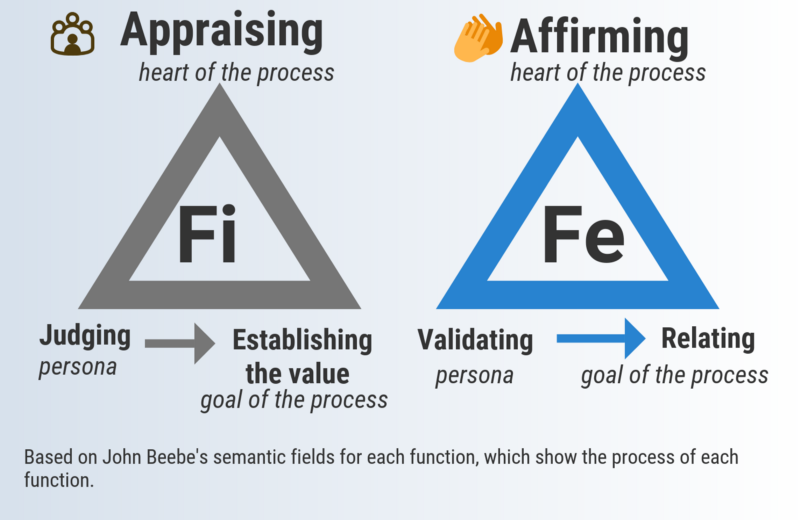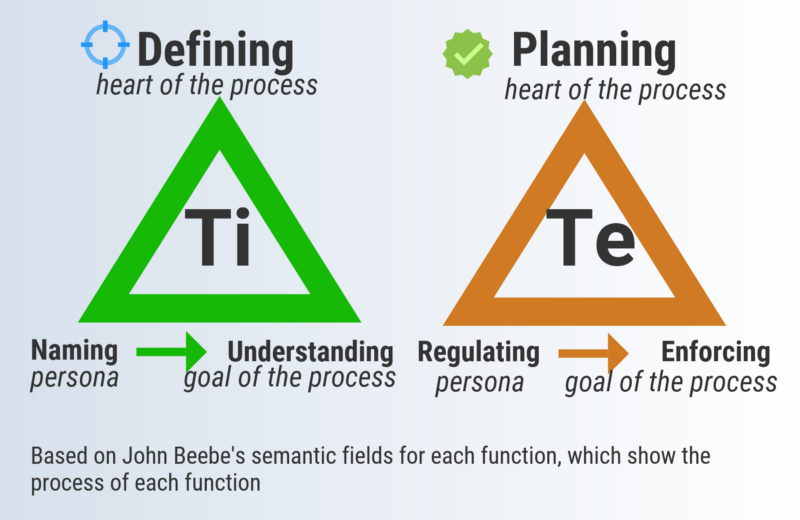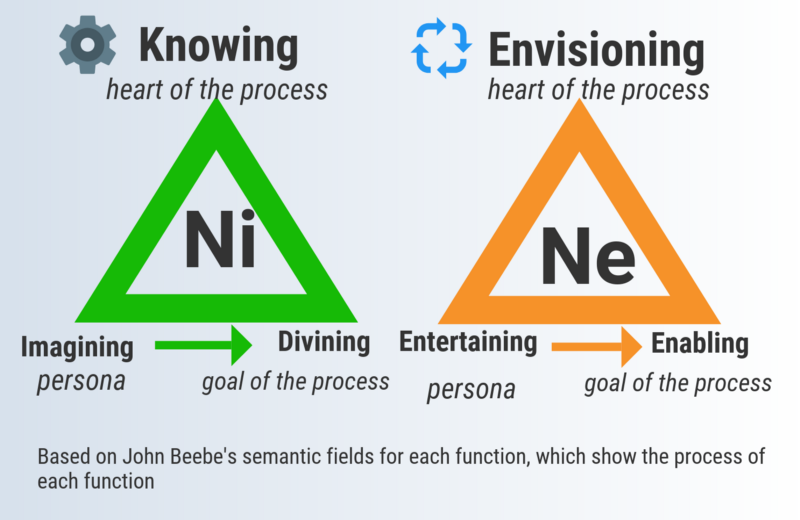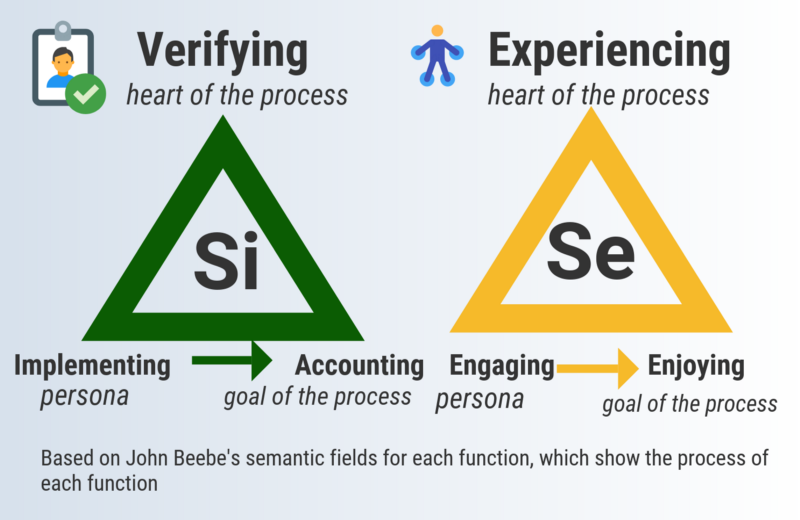Within the INFJ, the function of ‘introverted feeling’ (Fi) plays this highly unique role. On one hand, it is not one of this type’s four conscious/valued functions. On the other hand, as an ‘intuitive feeler’, INFJ will not exactly have a foreign relationship to it (to say the least). Given its strong, yet unvalued role within the psyche of the INFJ, it would be wise for them to tap into the energy of Fi, because throughout the course of the INFJ’s life, they are bound to have intimate interactions with it.
The best way to understand how Fi fits within the context of an INFJ is to contrast this function with Fe and Ni, two functions that INFJs will naturally use quite often. In fact, it would even be perceivable for INFJ’s understanding of Fi to serve as a growing edge for them in terms of how the feeling function can be optimally utilized when interacting with others.
Fi in contrast to Fe
An appropriate initial focal point in terms of viewing INFJ’s relationship to Fi is in contrast to its corresponding relationship to Fe. As the auxiliary/tool function, INFJs have a tendency to care very much about how they are perceived by others in terms of the impacts that they make in the outside world. They are typically friendly, caring and sociable individuals when they tap into their Fe. They will tend to be very attentive to others’ needs and agendas and may have a tendency to at times view their own direct needs as somewhat of a blind spot.
The Fi cognitive function cares very much about being attentive and receptive to their own internal values and priorities. As a result, it takes a highly specific psychological state for the INFJ’s unconscious Fi to become illuminated to such an extent where they have to pay attention to their own values and priorities above their natural proclivity to turn towards Fe. Often, this comes at times when they feel like an outsider by virtue of being isolated, left out or shut out, rejected, or betrayed. At times like those, while they may want to reflexively seek the approval of others, they may feel a greater need to fend for themselves and to provide a sense of inner support. However, because of this tendency to watch how they are perceived by the people close to them, they feel torn in their capacity to assert or defend themselves. As a result, the usage of Fi by the INFJ is often fraught with a sense of deep melancholy and sadness. How they can choose to convert this state into a growing edge will be discussed below.
Fi in contrast to Ni
Another function to compare to in terms of understanding what Fi means to the INFJ would be to compare it to their dominant function of Ni. The Ni of INFJs is all about distilling the essential, emergent truth in a manner that is observant of the events around them and is able to appropriately ‘fill in the blanks’ based on the signals and data (whether overt or hidden) that they are able to read and interpret.
While emotional content can at times mix into the emergent outcomes that Ni identifies, this cognitive function at its core does not necessarily have its roots within the emotional realm.
In contrast, Fi explores and excavates the emotional content of the self in order to tap into one’s core values and internal feelings. To this end, INFJs will not tend (as much as other types) to tap into their internal feeling states. In fact, they often serve as a blind spot. Rather, as Ni types, in more of a neutral, observational sense, they will tend to watch the trajectory of their own thought processes as a means towards capturing a wider sense of truth.
However, there are times in the INFJ’s life when they simply have to excavate into the deep recesses of their internal feelings and emotional content. This often needs to happen during states of loneliness, sadness, vulnerability, and other challenging states for INFJs to be immersed in. Thus, even when they feel like they will not need to directly access their Fi, life will sometimes grant them a harsh reality that forces them to encounter this function.
INFJ’s in an Fi state and the growth that can emerge
In order for INFJs to properly access their Fi, they will have to encounter many raw truths about themselves. They can come to the realization that others’ approval will not always save them from times of intense despair. They also will need to realize that at times, they will have to build strong boundaries for themselves so that others will not harm them in significant ways. At times like these, simply relying on their Fe function will not do them any good, since at these times, it will be more important to preserve their own self value and integrity, which Fi can naturally do quite effectively. In addition, the INFJ will likely be in a state of Fi-driven vulnerability and sadness, which makes it quite challenging for the individual to adequately navigate through. At the same time, coping with ways to deal with these Fi vulnerabilities may very well serve the INFJ well over the long term.
While in this state, it is of paramount importance that the INFJ respects themselves and has intense self compassion. After all, to handle these particular times well, an acceptance of their emotional and psychological state is pivotal. Also, it is important for them to be content regarding situations where they may need to extricate themselves from responding to or being around people who may expect them to respond in an Fe manner. If their Ni is guiding them that they are being overwhelmed by a given interpersonal situation, that is an important warning signal that is likely in their best interest to heed.
It is important in these vulnerable periods that they do not act or respond too impulsively in a way that overcompensates for their deep desire to temporarily separate from the given situation. It is likely better to ride out the storm by going inward and to take substantial time to try to regain their sense of equanimity, and to do this with a lot of self acceptance and self love. Then, once they feel a bit more ready to return to an outward Fe-driven state, they can do this in a graceful manner.
By having INFJs tap into their Fi function, they can access their sense of internal self worth. It basically allows them to put greater emphasis on putting themselves first, which (by having Fe valued and Fi not as valued) can come quite difficulty for these individuals.
By learning and growing in these seemingly vulnerable, yet transformative situations, they learn how to adapt their natural Fe to exhibit acceptable interpersonal boundaries. By successfully accomplishing this, they will be able to discriminate more effectively between people and situations that are beneficial for everyone involved and those that simply are not. In a nutshell, using Fi awareness to allow the INFJ to take the time to care for their own needs, priorities, and values will naturally facilitate an important shift towards greater empowerment in their lives.










